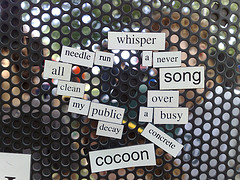Like this:
[blackbirdpie id=”68264891814907904″]
[blackbirdpie id=”68265062275620864″]
[blackbirdpie id=”68265874842320896″]
[blackbirdpie id=”68266016454619136″]
[blackbirdpie id=”68267276654215168″]
[blackbirdpie id=”68267739420176385″]
This is @eveningnews, and it’s not your average local news feed. Delivering a wry, funny take on the day’s news in Norwich, it’s not scared to poke fun at the newspaper – and the results are a far cry from the sterile RSS-based robots that many news brands use on Twitter.
@eveningnews has, at last count, nearly 3,700 followers – not bad for a local newspaper with a print circulation of 18,923 – and it’s talkative. It doesn’t follow many folks back but it does engage with the followers it has, talking back, retweeting and chatting about what’s going on.
The voice behind the tweeting is Stacia Briggs, current UK Columnist of the Year and feature writer for the Evening News, who also tweets as @womaninblack. She says that far from seeing Twitter as something difficult, it’s child’s play by comparison to traditional writing: “Give me 140 characters in comparison to 1,500 words any day.”
[blackbirdpie id=”67307714543493120″]
The feed was originally started by a colleague but quickly taken over by Stacia, and these days it’s very rare that anyone else uses it. Stacia admits being “extremely territorial”, and says that when the account was started she “was one of the only people on my newspaper who had some experience of Twitter – it’s not much of a basis for my unstinting belief that I could do the best job with the account, but it was a start”.
Like many folks looking at local news feeds, Stacia says she struggled to find something engaging out there – a feed that actually made people want to click on links, rather than simply treating the medium as a one-way publishing stream. So she set out to create something different.
“I consider the account to be fairly informal, hopefully amusing and friendly – sometimes a bit edgy and slightly naughty,” she says. “I don’t want bland RSS feeds or po-faced updates that command me to read a story. What I wanted to do is make the feed like a conversation: I’ll tweet a link, and then I’ll sometimes make an observation. Sometimes, the observations are quite oblique – I like oblique observations.”
[blackbirdpie id=”63961196159705089″]
“One of the things I feel most strongly about is maintaining a voice, one which people recognise and can relate to,” Stacia says.
“Clearly, there are stories which are serious and which must be treated as such. I don’t post a story about an inquest and then make a joke – if I did, I’d imagine it would be my career that required an inquest after a very sudden death.”
But between the straight tweets that link the reader to important stories and keep people up to date, @eveningnews is genuinely funny and wonderfully compelling. It’s a fantastic mix that makes readers feel they have a genuine relationship and a line into the paper – as is shown by the number of stories that come straight to Stacia via @eveningnews – and it has a nice side line in gently mocking the newspaper’s occasional online mishaps in a way that brings readers into an inside joke.
[blackbirdpie id=”65326299106902016″]
Looking at @edp24, a feed run out of the same office by the same team, the difference is clear – the Eastern Daily Press feed is entirely automated, even automatically passing on reporters’ tweets. The Eastern Daily Press has more than three times the circulation of the Evening News in print, and the circulation area is much wider – but it has just a few more followers than @eveningnews.
And despite regular attempts at engagement from the people who follow it, it simply doesn’t talk back. In this, it’s like most other news brands, both local and national – but it’s clear from what @eveningnews has achieved that much more is possible when someone committed and talented takes ownership and makes the news their own.
[blackbirdpie id=”66552417193439232″]
Readers tell @eveningnews their stories freely, they pass on ideas, they offer case studies and point out errors – but the open dialogue has drawbacks. Stacia doesn’t stop when she goes on holiday or is unwell – keeping @eveningnews going is a constant task that transcends normal work hours and boundaries. But it’s worth it, she says.
“There’s a mine of untapped data and information on Twitter which hugely benefits newspapers – and I’m trying to access it. I’ve got some great, breaking stories from Twitter, and within minutes we’ve had them on our websites.
“A huge city centre fire was first reported on Twitter and we then followed it with live tweeting, pictures from our photographers and Twitter followers and regularly updated reports. It directed people to our website and was a great example of how Twitter can break the news and we can expand on it.
“I’ve been given feature ideas, news stories, pictures, video, song clips – it’s been like a news sweet shop.”
[blackbirdpie id=”66192096729640960″]
And the best advice for people tweeting as news brands?
“Don’t churn out corporate slurry. Talk like a human being. Engage with people. Reply to people who talk to you. Look for the unusual in a story and highlight it. Encourage your reporters to find lots of stories about UFOs, big cats, sharks or local eccentrics – they’re Twitter gold.”
[blackbirdpie id=”65462760338759680″]
Full disclosure: I worked for the Evening News from 2008 to 2010, and I am a total Stacia fangirl. Stacia’s job at the Evening News is currently at risk due to Archant Norfolk’s editorial review.
 Tonight Twitter released a set of guides for newsrooms. There’s going to be a lot said about them in the next few days I’m sure, and it’ll be a while before we see what impact (if any) they have on the news ecosystem. But here are a few first impressions, in no particular order.
Tonight Twitter released a set of guides for newsrooms. There’s going to be a lot said about them in the next few days I’m sure, and it’ll be a while before we see what impact (if any) they have on the news ecosystem. But here are a few first impressions, in no particular order.

